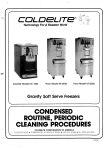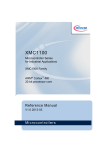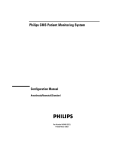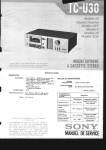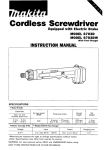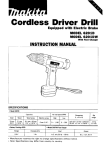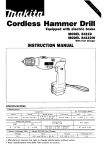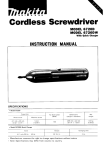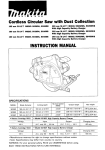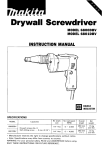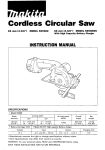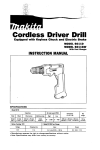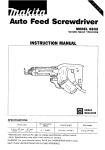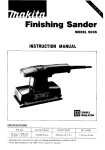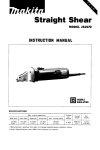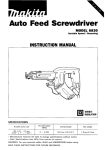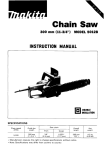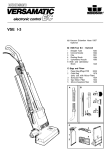Download Makita 5680DWB Specifications
Transcript
Cordless Circular Saw Equipped with Electric Brake MODEL 5630DWA MODEL 5680DWB With High Capacity Battery Charger With High Capacity Battery Charger Blade diameter 165 m m (6-1 / 2 " ) Cutting depth 45" 90" 54" 0 10 ~ 2-1/8") Battery Cartridge 1 4 2 2 0 - 38" 10 1-1/2") Net weight 2,600 364 m m (14-5116"J 3.2 kg (7.1 lbsl Model DC1411 High capacity Battery charger Input 144V A.C only 50 H r Voltage Overall length ~ Vo It age Battery Cartridge 1 4 3 3 No load speed iRPMi output ~ 60 Hz D.C. 7.2 V Charging time 14.4 V 1 Hr. Model DC1411 High capacity Battery charger Input output ~ * Manufacturer reserves t h e r i g h t t o change specifications w i t h o u t n o t i c e * N o t e Specifications m a y differ f r o m c o u n t r y to c o u n t r y WARNING For your personal safety, READ and UNDERSTAND before using SAVE THESE INSTRUCTIONS FOR FUTURE REFESENCE Charging time GENERAL SAFETY RULES (For All Battery Operated Tools) WARNING! Read and understand all instructions. Failure t o follow all instructions listed below, may result in electric shock, fire and/or serious personal injury. SAVE THESE INSTRUCTIONS Work Area Keep your work area clean and well lit. Cluttered benches and dark areas invite accidents. Do not operate power tools in explosive atmospheres, such as in the presence of flammable liquids, gases, or dust. Power tools create sparks which may ignite the dust or fumes. Keep bystanders, children, and visitors away while operating a power tool. Distractions can cause you t o loose control. Electrical Safety A battery operated tool with integral batteries or a separate battery pack must be recharged only w i t h the specified charger for the battery. A charger that may be suitable for one type of battery may create a risk of fire when used with another battery. Use battery operated tool only w i t h specifically designated battery pack. Use of any other batteries may create a risk of fire. Personal Safety Stay alert, watch what you are doing, and use common sense when operating a power tool. Do not use tool while tired or under the influence of drugs, alcohol, or medication. A moment of inattention while operating power tools may result in serious personal injury. Dress properly. Do not wear loose clothing or jewelry. Contain long hair. Keep your hair, clothing, and gloves away from moving parts. Loose clothes, jewelry, or long hair can be caught in moving parts. Avoid accidental starting. Be sure switch is in the locked or off position before inserting battery pack. Carrying tools w i t h your finger on the switch or inserting the battery pack into a tool with the switch on invites accidents. Remove adjusting keys or switches before turning the tool on. A wrench or a key that is left attached to a rotating part of the tool may result in personal injury. Do not overreach. Keep proper footing and balance at all times. Proper footing and balance enable better control of the tool in unexpected situations. Use safety equipment. Always wear eye protection. Dust mask, nonskid safety shoes, hard hat, or hearing protection must be used for appropriate conditions. 2 Tool Use and Care Use clamps or other practical way t o secure and support the workpiece t o a stable platform. Holding the work by hand or against your body is unstable and may lead t o loss of control. *Do not force tool. Use the correct tool for your application. The correct tool will do the job better and safer at the rate for which it is designed. * D o n o t use tool i f switch does not turn it o n or off. A tool that cannot be controlled with the switch is dangerous and must be repaired. Disconnect battery pack from tool or place the switch in the locked or off position before making any adjustments, changing accessories, or storing the tool. Such preventive safety measures reduce the risk of starting the tool ac c id e ntaIIy. Store idle tools out of reach of children and other untrained persons. Tools are dangerous in the hands of untrained users. When battery pack is not in use, keep it away from other metal objects like: paper clips, coins, keys, nails, screws, or other small metal objects that can make a connection from one terminal t o another. Shorting the battery terminals together may cause sparks, burns, or a fire. Maintain tools with care. Keep cutting tools sharp and clean. Properly maintained tools with sharp cutting edge are less likely t o bind and are easier t o control. Check for misalignment or binding of moving parts, breakage of parts, and any other condition that may affect the tool's operation. If damaged, have the tool serviced before using. Many accidents are caused by poorly maintained tools. Use only accessories that are recommended by the manufacturer for your model. Accessories that may be suitable for one tool may create a risk of injury when used on another tool. Service Tool service must be performed only by qualified repair personnel. Service or maintenance performed by unqualified personnel may result in a risk of injury. When servicing a tool, use only identical replacement parts. Follow instructions in the Maintenance section of this manual. Use of unauthorized parts or failure t o follow Maintenance Instructions may create a risk of shock or injury. 3 Specific Safety Rules 1. DANGER! Keep hands away from cutting area and blade. Keep your second hand on auxiliary handle, or motor housing. If both hands are holding the saw, they cannot be cut by the blade. Keep your body positioned t o either side of the saw blade, but not in line w i t h the saw blade. KICKBACK could cause the saw t o jump backwards. (See "Causes and Operator Prevention of Kickback") Do not reach underneath the work. The guard can not protect you from the blade below the work. Don't attempt t o remove cut material when blade is moving . CAUTION: Blades coast after turn off. 2. Check lower guard for proper closing before each use. Do not operate saw if lower guard does not move freely and close instantly. Never clamp or tie the lower guard into the open position. If saw is accidentally dropped, lower guard may be bent. Raise the lower guard with the Retracting Handle and make sure it moves freely and does not touch the blade or any other part, in all angles and depths of cut. 3.Check the operation and condition of the lower guard spring. If the guard and the spring are not operating properly, they must be serviced before use. Lower guard may operate sluggishly due t o damaged parts gummy deposits, or a buildup of debris. 4. Lower guard should be retracted manually only for special cuts such as "Pocket Cuts" and "Compound Cuts." Raise lower guard by Retracting Handle. As soon as blade enters the material, lower guard must be released. For all other sawing, the lower guard should operate automatically. 5. Always observe that the lower guard is covering the blade before placing saw down on bench or floor. An unprotected, coasting blade will cause the saw t o walk backwards, cutting whatever is in its path. Be aware of the time it takes for the blade t o stop after switch is released. 6. NEVER hold piece being cut in your hands or across your leg. It is important t o support the work properly to minimize body exposure, blade binding, or loss of control. 7. Hold tool by insulated gripping surfaces when performing an operation where the cutting tool may contact hidden wiring or its o w n cord. Contact w i t h a "live" wire will also make exposed metal parts of the tool "live" and shock the operator. 8. When ripping always use a rip fence or straight edge guide. This improves the accuracy of cut and reduces the chance for blade binding. 9. Always use blades w i t h correct size and shape (diamond vs. round) arbor holes. Blades that do not match the mounting hardware of the saw will run eccentrically, causing loss of control. IO. Never use damaged or incorrect blade washers or bolts. The blade washers and bolt were specially designed for your saw, for optimum performance and safety or operation. 4 11. Causes and Operator Prevention of Kickback: Kickback is a sudden reaction to a pinched, bound or misaligned saw blade, causing an uncontrolled saw to lift up and out of the workpiece toward the operator. When the blade is pinched or bound tightly by the kerf closing down, the blade stalls and the motor reaction drives the unit rapidly back toward the operator. If the blade becomes twisted or misaligned in the cut, the teeth at the back edge of the blade can dig into the top surface of the wood causing the blade to climb out of the kerf and jump back toward operator. Kickback is the result of tool misuse and/or incorrect operating procedures or conditions and can be avoided by taking proper precautions as given below. Maintain a firm grip with both hands on the saw and position your body and arm t o allow you t o resist KICKBACK forces. KICKBACK forces can be controlled by the operator, if proper precautions are taken. When blade is binding, or when interrupting a cut for any reason, release the trigger and hold the saw motionless in the material until the blade comes t o a complete stop. Never attempt t o remove the saw from the work or pull the saw backward while the blade is in motion or KICKBACK may occur. Investigate and take corrective actions t o eliminate the cause of blade binding. When restarting a saw in the workpiece, center the saw blade in the kerf and check that saw teeth are not engaged into the material. If saw blade is binding, it may walk up or KICKBACK from the workpiece as the saw is restarted. Support large panels t o minimize the risk of blade pinching and KICKBACK. Large panels tend t o sag under their o w n weight. Supports must be placed under the panel on both sides, near the line of cut and near the edge of the panel as shown in Fig. 1. To minimize the risk of blade pinching and kickback. When cutting operation requires the resting of the saw on the work piece, the saw shall be rested on the laraer Dortion and the smaller ece cut off. To avoid kickback do support board or panel near the cut. Don't support board or panel away from the cut. Fig. ' Fig. : 5 Do not use dull or damaged blade. Unsharpened or improperly set blades produce narrow kerf causing excessive friction, blade binding and KICKBACK. Blade depth and bevel adjusting locking levers must be tight and secure before making cut. If blade adjustment shifts while cutting, it may cause binding and KICKBACK. Use extra caution when making a "Pocket Cut" into existing walls or other blind areas. The protruding blade may cut objects that can cause KICKBACK. NEVER place your hand or fingers behind the saw. If kickback occurs, the saw could easily jump backwards over your hand, possibly causing severe injury. Fig. 3 12. Adjustments. Before cutting be sure depth and bevel adjustments are tight. 13. Avoid Cutting Nails. Inspect for and remove all nails from lumber before cutting. 14. When operating the saw, keep the cord away from the cutting area and position it so that it will not be caught on the workpiece during the cutting operation. Operate w i t h proper hand support, proper workpiece support, and supply cord routing away from the work area. A typical illustration of proper hand support, workpiece support, and supply cord routing. Fig. 1 WARN ING : It is important t o support the workpiece properly and t o hold the saw firmly t o prevent loss of control which could cause personal injury. Fig. 4 illustrates typical hand support of the saw. 6 15. Place the wider portion of the saw base o n that part of the workpiece which is solidly supported, not on the section that will fall off when the cut is made. As examples, Fig. 5 illustrates the RIGHT way t o cut off the end of a board, and Fig. 6 the WRONG way. If the workpiece is short or small, clamp it down. DON'T TRY TO HOLD SHORT PLACES BY HAND! Fig. Fig. circular saw held upside down in a vise. This is extremely dangerous and can lead t o serious accidents. I Fig. ' 17. Before setting the tool down after completing a cut, be sure that the lower (telescoping) guard has closed and the blade has come t o a complete stop. 7 SYMBOLS The followings show the symbols used for tool. ...... volts ................................. amperes ................................. herts ................................. kilograms ................................. minutes ................................. seconds ................................. alternating current ................................. direct current ................................. no load speed ................................. alternating or direct current ................................. Class II Construction ...... splash-proof construction ................................. watertight construction ............. revolutions or reciprocation per minute ................................. number of blow hours c- 8 IMPORTANT SAFETY INSTRUCTIONS FOR CHARGER & BATTERY CARTRIDGE 1. SAVE THESE INSTRUCTIONS - This manual Length of Cord (Feet) 25 50 100 150 AWG Size of Cord 18 18 18 16 9 ADDITIONAL SAFETY RULES FOR CHARGER & BATTERY CARTRIDGE 1. Do n o t charge Battery Cartridge when temperature is BELOW 10°C (50OFI or ABOVE 4OoC (104OF). 2. Do not attempt t o use a step-up transformer, an engine generator or DC power receptacle. 3. Do not allow anything t o cover or clog the charger vents. 4. Always cover the battery terminals with the battery cover when the battery cartridge is not used. 5. A battery short can cause a large current flow, overheating, possible burns and even a breakdown. (11 Do not touch the terminals with any conductive material. (2) Avoid storing battery cartridge in a container with other metal objects such as nails, coins, etc. (3)Do n o t expose battery cartridge t o water or rain. 6. Do not store the tool and Battery Cartridge in locations where the temperature may reach or exceed 5OoC (122OF). 7. Do not incinerate the Battery Cartridge even i f it is severely damaged or is completely worn out. The battery cartridge can explode in a fire. SAVE THESE INSTRUCTIONS. 10 Installing or removing battery cartridge *Always switch off the tool before insertion or removal of the battery cartridge. *To remove the battery cartridge, withdraw it from the tool while pressing the buttons on both sides of the cartridge. *To insert the battery cartridge, align the tongue on the battery cartridge with the groove in the housing and slip it into place. Always insert it all the way until it locks in place with a little click. If not, it may accidentally fall out of the tool, causing injury to you or someone around you. Fig. 8 *Do not use force when inserting the battery cartridge. If the cartridge does not slide in easily, it is not being inserted correctly Charging *Your new battery cartridge is not charged. You will need to charge it before use. Use the high capacity battery charger Model DC1411 to charge the battery cartridge. *Plug the high capacity battery charger into the proper A.C. voltage source. The charging light will flash in green color. *Insert the battery cartridge so that the plus and minus terminals on the battery cartridge are on the same sides as their respective markings on the high capacity Battery cartridge Charg'ng'lght 11 *If you charge a battery cartridge from a just-operated tool or a battery cartridge which has been left in a location exposed to direct sunlight or heat for a long time, the charging light may flash in red color. If this occurs, wait for a while. Charging will begin after the battery cartridge cools. The battery cartridge will cool faster if you remove the battery cartridge from the high capacity battery charger. *If the charging light flashes alternately in green and red color, a problem exists and charg ing is not possible. The terminals on the charger or battery cartridge are clogged with dust or the battery cartridge is worn out or damaged. Removing or installing the saw blade CAUTION: Always be sure that the tool is switched off and the battery cartridge is removed before installing or removing the blade. To remove the blade, press the shaft lock so that the blade cannot revolve and use the hex wrench to loosen the bolt clockwise. Then remove the bolt, outer flange and blade. :wrench I I Fig. 10 To install the blade, follow the removal procedure in reverse. BE SURE TO TIGHTEN THE BOLT SECURELY. Saw blade Fig. 11 CAUTlON: *Be sure the blade is installed with teeth pointing up at the front of the tool *Use only the Makita hex wrench to install or remove the blade. 12 Hex wrench storage When not in use, the hex wrench can be conveniently stored. CAUTION: Always be sure that the tool is switched off and the battery cartridge is removed before any adjustment is attempted. Adjusting depth of cut Loosen the lever on the depth guide and move the base up or down. At the desired depth of cut, secure the base by tightening the lever. I I CAUTION: .Use a shallow depth of cut when cutting thin workpiece for cleaner, safer cuts. *After adjusting the depth of cut, always tighten the lever securely. Fig. 13 Bevel cutting Loosen the screw on the bevel scale plate on the front of the base. Set for desired angle (0" - 50") by tilting accordingly, then tighten the clamp screw securely. I Bevel scale p l a 4 1 Screw CAUTION: After adjusting the depth of cut and bevel cutting angle, be sure to tighten the screw. Sighting The front of the base is notched to provide two guide edges. For straight cuts, align the edge with 0" engraved on it with your cutting line on the workpiece. For 45" bevel cuts, align the edge with 45" engraved on it with your cutting line. For 45" bevel cuts I For straight cuts Cutting line I Fig. 17 Switch action CAUTION: Before inserting the battery cartridge into the tool, always check to see that the switch trigger actuates properly and returns to the "OFF" position when released. To prevent the switch trigger from being accidentally pulled, a lock-off button is provided. To start the tool, depress the lock-off button and pull the switch trigger. Release the switch trigger to stop. Fig. 18 14 Operation Hold the tool firmly. Set the base plate on the workpiece to be cut without the blade making any contact. Then turn the tool on and wait until the blade attains full speed. Now simply move the tool forward over the workpiece surface, keeping it flat and advancing smoothly until the sawing is completed. To get clean cuts, keep your sawing line straight and your speed of advance uniform. Fig. 19 CAUTION: *Always gently keep the tool moving straight ahead when cutting. Forcing or twisting the tool will result in overheating of the motor and dangerous kickback, possibly causing severe injury. *If the tool is operated continuously until the battery cartridge has discharged, allow the tool to rest for 15 minutes before proceeding with a fresh battery. Guide rule The handy guide rule allows you to do extra-accurate straight cuts. Simply slide the guide rule up snugly against the side of the workpiece and secure it in position with the clamp screw on the front of the base. It also makes repeated cuts of uniform width possible. Fig. 20 15 MAINTENANCE CAUTION: Always be sure that the tool is switched off and the battery cartridge is removed before attempting to perform inspection or maintenance. Replacing carbon brushes Remove and check the carbon brushes regularly. Replace when they wear down to the limit mark. Keep the carbon brushes clean and free to slip in the holders. Both carbon brushes should be replaced at the same time. Use only identical carbon brushes. Limit mark I I I Fig. 21 Use a screwdriver to remove the brush holder caps. Take out the worn carbon brushes, insert the new ones and secure the brush holder caps. Fig. 22 To maintain product SAFETY and RELIABILITY, repairs, maintenance or adjustment should be performed by Makita Authorized or Factory Service Centers, always using Makita replacement parts. Trickle charge (Maintenance charge) If you leave the battery cartridge in the charger to prevent spontaneous discharging after full charge, the charger will switch into its "trickle charge (maintenance charge)" mode and keep the battery cartridge fresh and fully charged. Tips for maintaining maximum battery life 1. Charge the battery cartridge before completely discharged. Always stop tool operation and charge the battery cartridge when you notice less tool power. 2. Never recharge a fully charged battery cartridge. Overcharging shortens the battery service life. 3. Charge the battery cartridge with room temperature at 10°C - 40°C (50°F Let a hot battery cartridge cool down before charging it. 16 - 104°F). Recycling the Battery The only way to dispose of a Makita battery is to recycle it. The law prohibits any other method of disposal. Ni-Cd To recycle the battery: 1. Remove the battery from the tool. 2. a). Take the battery to your nearest Makita Factory Service Center or b). Take the battery to your nearest Makita Authorized Service Center or Distributor that has been designated as a Makita battery recycling location. Gall your nearest Makita Service Center or Distributor to determine the location that provides Makita battery recycling. See your local Yellow Pages under "Tools-€lectric': ACCESSORIES CAUTION These accessories or attachments are recommended for use with your Makita tool specified in this manual The use of any other accessories or attachments might present a risk of inlury t o persons The accessories or attachments should be used only in the proper and intended manner High capacity battery charger DC1411 High capacity battery 142211433 Part No 192700-7 1422 1433 Battery cover Hex wrench Part No. 783203-8 Part No.414938-7 Tungsten carbide tipped saw blade For wood Part No 726008-3 - Part No - Part No 192600-1 192699-6 Hole diameter (mm) No teeth (mm) 165 (6-1/2") 15 88 (5/8") 24 Diameter Feb-04--'99 US CORDLESS CIRCULAR SAW Model 5630DW e-59 Note: The switch and other part ConfigUratlOnS may differ from country to Country. 18 Feb-04-'99 MODEL 5630DW I:"," GtD MACHINE MACHINE ~ 1 2 3 4 5 6 7 8 9 10 11 12 13 14 15 16 17 18 19 20 21 22 23 24 25 6 1 1 1 1 1 1 1 1 1 1 2 2 2 1 1 Tapping Screw 4x18 Switch Button 1 1 3 Rpar Cover 26 21 28 29 30 1 1 1 1 1 1 1 DESCRIPTION DESCRIPTION ~ 2 1 1 1 US Compresslo" Spring 4 Handle Cover Switch Lever Switch Battery Holder Stop Ring E - 8 Lever 40 Hex N u t M 6 Flat Washer 6 Tapping Screw 4x18 Holder Cap Carbon Brush 35 36 31 38 39 40 41 42 1 1 2 1 1 1 1 1 1 Brush Holder Brush Holder Name Plate Pan Head Screw M5x40 Tapping Screw M i 4x60 Motor Housing Ball Bearing 627LLB Yoke Unit Baffle Plate ARMATURE ASSEMBLY (With Item 22 & 261 Ball Bearing 6000LLB Shaft Lock Compresslo" Spring 5 Blade Case Complete Rubber Rina 6 Countersunk Screw M 6 Makita Label Ball Bearing 606 Ring 12 Spur Gear 53 Countersunk Head Screw M5x16 Bearing Box Ball Bearing 6201DDW Spindle Bearing Retainer 1 9 - 3 3 Tension Spring 3 Safety Cover Retaining Ring S 38 Inner Flange 40 Outer Flange 40 Hex Socket Head Bolt M6x20 Screw M6x14 compress,on s p m g 7 Hex Lock N u t M 5 - 8 Depth Complele S p m q Washer 6 Screw M6x14 Flat Washer 6 Pan Head Screw M 5 Angular Complete Flat Hpad Srraw M6x90 Countersunk Head Screw M4x8 Base Screw M5x12 Countersunk Head Screw M5x8 Note The switch and other part specificdtions may differ from country to country 19 1 MAKITA LIMITED ONE YEAR WARRANTY Warranty Policy Every Makita tool is thoroughly inspected and tested before leaving the factory. It is warranted to be free of defects from workmanship and materials for the period of ONE YEAR from the date of original purchase. Should any trouble develop during this one-year period, return the COMPLETE tool, freight prepaid, to one of Makita’s Factory or Authorized Service Centers. If inspection shows the trouble is caused by defective workmanship or material, Makita will repair (or at our option, replace) without charge. II This Warranty does not apply where: repairs have been made or attempted by others: repairs are required because of normal wear and tear: The tool has been abused, misused or improperly maintained; alterations have been made to the tool. IN NO EVENT SHALL MAKITA BE LIABLE FOR ANY INDIRECT, INCIDENTAL OR CONSEQUENTIAL DAMAGES FROM THE SALE OR USE O F THE PRODUCT. THIS DISCLAIMER APPLIES BOTH DURING AND AFTER THE TERM OF THIS WARRANTY. MAKITA DISCLAIMS LIABILITY FOR ANY IMPLIED WARRANTIES, INCLUDING IMPLIED WARRANTIES O F “MERCHANTABILITY” AND “FITNESS FOR A SPECIFIC PURPOSE.’’ AFTER THE ONE-YEAR TERM OF THIS WARRANTY. This Warranty gives you specific legal rights, and you may also have other rights which vary from state to state. Some states do not allow the exclusion or limitation of incidental or consequential damages, so the above limitation or exclusion may not apply to you. Some states do not allow limitation on how long an implied warranty lasts, so the above limitation may not apply to you. i __cu Makita Corporation of America 2650 Buford Hwy., Buford, GA 30518 884232-067 PRINTED IN USA 1999-2- N





















